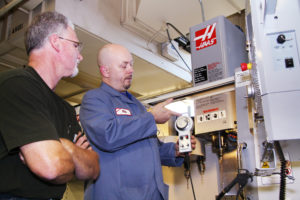The man Chris Hansen refers to as “Mr. F” had no interest in college when he got out of prison. He just wanted a job.
But after three months of hearing “no thanks” from employers, he showed up at Hansen’s door with a Department of Corrections officer.
“He was in utter dismay,” recalls Hansen, a reentry navigator for Bates Technical College in Tacoma, Washington. “I talked with him about short-term training options: eight weeks, six certifications, and some help with job placement. He reluctantly agreed to give it a try.”
Six weeks into the college’s Manufacturing Academy program, Mr. F was hired by a local manufacturing plant. Three months later, he was enrolled in a pre-apprenticeship program for electrical construction.
“College is still not what he wants,” Hansen notes, “but we were able to provide him with a service that was helpful in moving him into a career.”
Hansen is one of nine reentry navigators for the state of Washington, tasked with helping inmates get the job training and employment they need to be productive citizens upon their release. The navigator positions were established by the Washington State Board for Community and Technical Colleges with a grant from the Department of Corrections.
In creating these positions, the state board recognized the critical role that community colleges play in preparing nontraditional students for successful careers.
Across the nation, community colleges are serving an increasing number of adults who are trying to learn new skills or return to the workforce. Some of these students offer particular challenges, such as newly released prisoners, older adults and veterans transitioning to civilian life.
This excerpt comes from the current issue of the American Association of Community Colleges’ Community College Journal.
While each of these nontraditional populations has its own unique challenges, they all can be served more effectively with a coordinated effort that involves wraparound services and extra attention to their specific needs.
From prison to the workforce
In 1994, Congress amended the Higher Education Act to eliminate Pell Grant eligibility for students in federal and state correctional facilities. A pilot project that began in 2015 under the Obama administration restored Pell Grant eligibility for incarcerated students taking classes at 67 colleges and universities, including many community colleges.
In announcing the change, federal officials noted a 2013 study from the RAND Corporation that suggested inmates were 43 percent less likely to return to prison within three years if they took part in educational programs while they were incarcerated.
Bates Technical College is not a Second Chance Pell Grant recipient, but it is part of a statewide effort to connect prisoners with education and career training upon their release. These efforts begin while inmates are still on the inside.

Bates Technical College’s Manufacturing Academy provides students with a hands-on education, as well as soft skills. (Photo: BTC)
As a reentry navigator, Hansen describes his role as a “bridge” to employment opportunities for inmates who are about to be released. He spends much of his time in the state’s correctional facilities, holding college nights and running peer-to-peer programs. He also meets individually with prisoners to discuss their plans for when they get out.
“When I sit down with them one-on-one, it’s about listening to who they are and what they want, but at the same time I have resources available from L&I (the state’s Labor & Industries Department) that indicate the jobs in high demand,” he says. “I use a profiler to come up with ideas for careers they might like. And I help them create a 72-hour plan that outlines their goals within the first three days of their release, while they still have momentum.”
Ideally, these goals would include attending Bates or another community college to get the job skills they’ll need for a stable career. Yet, encouraging them to enroll is easier said than done.
“The biggest challenge we face is getting them to come through the door for the first time,” Hansen explains. “These students don’t feel like they belong at a college. A lot of them are disenfranchised with education. Many were early dropouts. Their lifestyle growing up was not conducive to education. Those who completed high school did so only because they showed up, but they weren’t really engaged in school. And some might still be reading at a third-grade level.”
‘You belong in college’
To overcome this barrier, Hansen tries to communicate the message: “You belong in college. Our college is built for you. College doesn’t have to be like what you’ve seen in the movies. There is a path for you, too.”
The Manufacturing Academy is a prime example. It’s an eight-week pre-apprenticeship program offered in conjunction with Tacoma’s Aerospace Joint Apprenticeship Committee (AJAC). During the program, students develop experience with basic hand tools, composites, metal fabrication, assembly, precision measuring tools, manufacturing equipment, blueprint reading and industrial safety, among other skills. They learn effective communication, resume writing and interviewing skills; earn six industry certifications, including CPR/First Aid and OSHA 10; and connect with local manufacturers and aerospace companies to discuss potential employment.
Getting former inmates comfortable with returning to school also involves building a sense of community. “There is a big difference between reentry and reintegration,” Hansen says. “We want to make sure that when they do come through that door, they’re not alone — they feel like they belong here.”
Before inmates are released, he helps them fill out whatever paperwork they need to enroll and apply for benefits. Once they are released, he takes them to the campus and introduces them to the office staff.
“I try to meet them where they are and walk them through the process,” he says. “That’s hard to do on a massive scale, so we are creating a peer-to-peer mentorship program as well. We’re using evidence-based practices from the Vera Institute of Justice to train mentors on campus.”
Of the 942 men and women who returned to Pierce County from incarceration between June 2017 and January 2018, nearly half lacked a high school diploma or GED. To help them earn their diploma, the state offers a program called High School 21+ for adults ages 21 and older, which grants high school credit for experiential learning. If students are under 21, they can earn dual high school and college credit from Bates.
Of course, finances are another key barrier for students coming out of prison — and Hansen helps them find the money they need to enroll in training programs.
“Almost all of them are considered low-income, so they qualify for programs targeting that population,” he says. These include Basic Food, Employment, and Training (BFET) dollars from the state, as well as Supplemental Security Income money, Vocational Rehabilitation grants and other workforce training grants. “I work closely with our financial aid department to find out what resources are available,” he notes.

